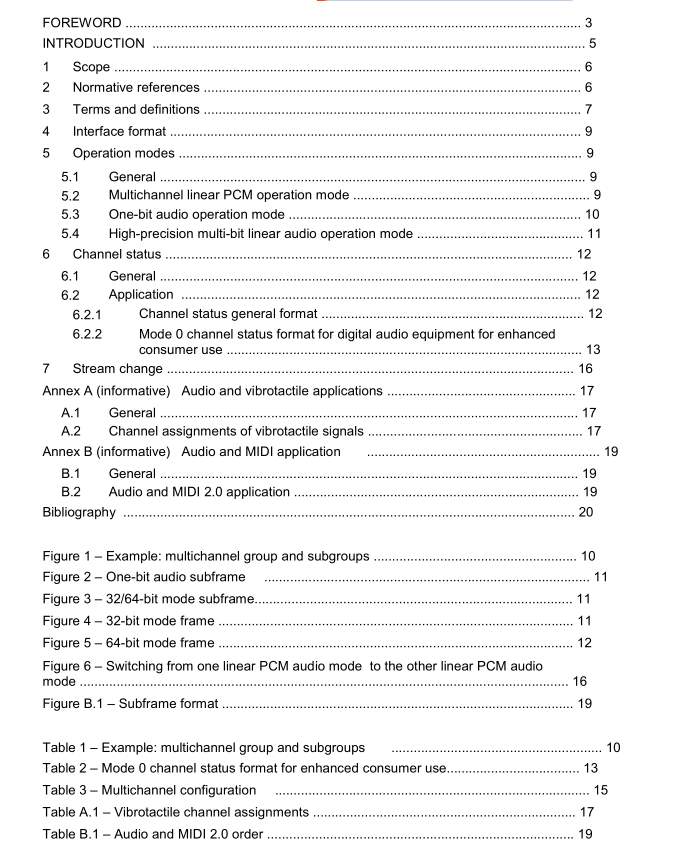IEC 60958-5 pdf – Digital audio interface – Part 5: Consumer application enhancement

IEC 60958-5 pdf – Digital audio interface – Part 5: Consumer application enhancement
3 Terms and definitions
For the purposes of this document, the following terms and definitions apply.
ISO and IEC maintain terminological databases for use in standardization at the following addresses:
IEC Electropedia: available at http://www.electropedia.org/
ISO Online browsing platform: available at http://www.iso.org/obp
3.1
one-bit audio
one-bit length audio data stream
Note 1 to entry: A one-bit audio data stream can be directly played back through the analogue low-pass filter bit by bit (MSB first).
3.2
high-precision multi-bit linear audio
linear PCM audio data longer than 25 bits length per sample
Note 1 to entry: This document supports 32- and 64-bit lengths.
3.3
sampling frequency
frequency of the samples representing an audio signal.
Note 1 to entry: When more than one signal is transmitted through the same interface, the sampling frequencies are identical.
[SOURCE: IEC 60958-1:20—, 3.1]
3.4
audio sample word
value of a digital audio sample
Note 1 to entry: Representation is linear in 2’s complement binary form.
Note 2 to entry: Positive numbers correspond to positive analogue voltages at the input of the analogue-to-digital converter (ADC).
[SOURCE: IEC 60958-1: 20—, 3.2]
3.5
channel status
data carrying, in a fixed format, information associated with each main data field channel, which is decodable by any interface user.
Note 1 to entry: IEC 60958-3 specifies the mode 0 channel status format for digital audio equipment for consumer use.
EXAMPLE 1 Length of audio sample words.
EXAMPLE 2 Sampling frequency.
[SOURCE: IEC 60958-1:20—, 3.5, modified – Modification of the Note to entry, and addition of two examples.]
3.6
preamble
specific patterns used for synchronization.
Note 1 to entry: There are three different preambles: “B”; “M”; and “W”.
[SOURCE: IEC 60958-1:20—, 3.8, modified – Modification of the Note to entry.]
3.7
sub-frame
fixed structure used to carry information
[SOURCE: IEC 60958-1:20—, 3.9]
3.8
frame
sequence of two successive and associated sub-frames
[SOURCE: IEC 60958-1:20—, 3.10]
3.9
block
group of 192 consecutive frames
Note 1 to entry: The start of a block is designated by a special sub-frame preamble.
[SOURCE: IEC 60958-1:20—, 3.11]
3.10
channel number
number that shows channel order in two-channel operation mode
3.11
channel label ID
label of ID
[SOURCE: IEC 62574:2020, 3.73]
3.11.1
multichannel number
number that identifies multichannel addressing
Note 1 to entry: Same as IEC 62574 channel number
3.12
multichannel group
group composed of one or two multichannel subgroups
3.13
multichannel count
count of channels in a multichannel group
3.14
multichannel subgroup
subgroup, in a multichannel group, composed of several multichannel
Note 1 to entry: Multichannel subgroup A is set according to multichannel configuration.
Note 2 to entry: Multichannel subgroup B is set according to multichannel map.
3.15
multichannel configuration
configuration of multichannel addressing
3.16
multichannel order
order of multichannel in a multichannel group
3.17
multichannel map
map of multichannel selections
4 Interface format
The interface format as defined in IEC 60958-1 and IEC 60958-3 shall be used unless otherwise specified in this document.
5 Operation modes
5.1 IEC 60958-1 specifies single- and two-channel operation modes. This document introduces several new operation modes based on the same interface format of IEC 60958-1 without the pre-emphasis function defined in IEC 60958-3. Channel status information identifies these modes in operation. This document shares the information with IEC 60958-1 and IEC 60958-3 and specifies new usages.
5.2 Multichannel linear PCM operation mode In multichannel linear PCM operation mode, the samples taken from multichannel linear PCM are transmitted by time multiplexing in consecutive sub-frames. A multichannel group is composed of several multichannel by consecutive frames. The number of multichannels included in the group is identified by the multichannel count of channel status bits 44 to 47. The group starts with preamble “B” and repeats itself with no break in the block and without un-grouped frames. The group is divided into one or two multichannel subgroups by the multichannel configuration of channel status bits 49 to 60 and the multichannel map of channel status bits 64 to 165. The subgroup is composed of some specific multichannels by consecutive sub-frames. Each multichannel within the multichannel subgroup B is re-numbered according to the multichannel number of channel status bits 64 to 165. Each channel carries consecutive audio sample words. An example is shown in Figure 1 and Table 1. The multichannel group is composed of eight multichannels. This number of eight is identified by the multichannel count value of “1110”. The multichannel subgroup A is composed of three multichannels identified by the multichannel configuration value of “100001010000”, which includes FrontLeft channel, FrontRight channel and FrontCenter channel given in ITU-R BS.2094-1. The multichannel subgroup B is composed of the 77 th multichannel (channel label ID name of HFL) and 78th multichannel (channel label ID name of HFR) by setting the channel status bit 77 to “1” and the channel status bit 78 to “1”. Channels of multichannel order 6, 7 and 8 are not used in this example.









